Invented by Shyamala Chalakudi, Ming Yin, American Express Travel Related Services Co Inc
Data file transfer balancing and control are critical aspects of any organization’s operations, especially in industries dealing with large volumes of data such as finance, healthcare, supply chain, and logistics. Traditional methods of data transfer and control often face challenges such as security breaches, data loss, and lack of transparency. These issues can lead to financial losses, reputational damage, and legal complications.
Blockchain technology offers a solution to these challenges by providing a decentralized and secure platform for data file transfer and control. With blockchain, data files are broken into smaller chunks, encrypted, and distributed across multiple nodes in the network. This ensures that no single entity has complete control over the data, making it resistant to hacking and manipulation.
Furthermore, blockchain’s immutability feature ensures that once a data file is recorded on the blockchain, it cannot be altered or deleted. This provides a transparent and auditable trail of data transfers, enabling organizations to track and verify the authenticity and integrity of their data.
The market for systems and methods for data file transfer balancing and control on blockchain is driven by several factors. Firstly, the increasing need for secure and efficient data transfer in industries dealing with sensitive information such as personal health records, financial transactions, and intellectual property. Blockchain technology provides a robust solution to protect such data from unauthorized access and tampering.
Secondly, the growing adoption of cloud computing and the Internet of Things (IoT) has led to an exponential increase in data generation and transfer. Traditional methods of data transfer and control are struggling to keep up with the volume and speed required by these technologies. Blockchain-based systems offer a scalable and efficient solution to handle the massive amounts of data generated by cloud computing and IoT devices.
Thirdly, regulatory compliance is becoming more stringent in many industries, requiring organizations to have better control and transparency over their data transfers. Blockchain technology provides a tamper-proof and auditable record of data transfers, making it easier for organizations to demonstrate compliance with regulations such as the General Data Protection Regulation (GDPR) and the Health Insurance Portability and Accountability Act (HIPAA).
The market for systems and methods for data file transfer balancing and control on blockchain is witnessing a surge in innovation and competition. Numerous startups and established technology companies are developing blockchain-based solutions to address the challenges faced by organizations in data transfer and control.
These solutions range from decentralized file storage platforms that leverage blockchain technology to ensure data security and availability, to smart contract-based systems that automate and enforce data transfer agreements. Additionally, there are companies focusing on developing interoperability protocols to enable seamless data transfer and control across different blockchain networks.
In conclusion, the market for systems and methods for data file transfer balancing and control on blockchain is experiencing rapid growth and is set to disrupt traditional methods of data transfer and control. With its decentralized and secure nature, blockchain technology provides a robust solution to protect sensitive data, ensure transparency, and comply with regulatory requirements. As organizations increasingly recognize the importance of efficient and secure data transfer, the demand for blockchain-based solutions in this market will continue to rise.
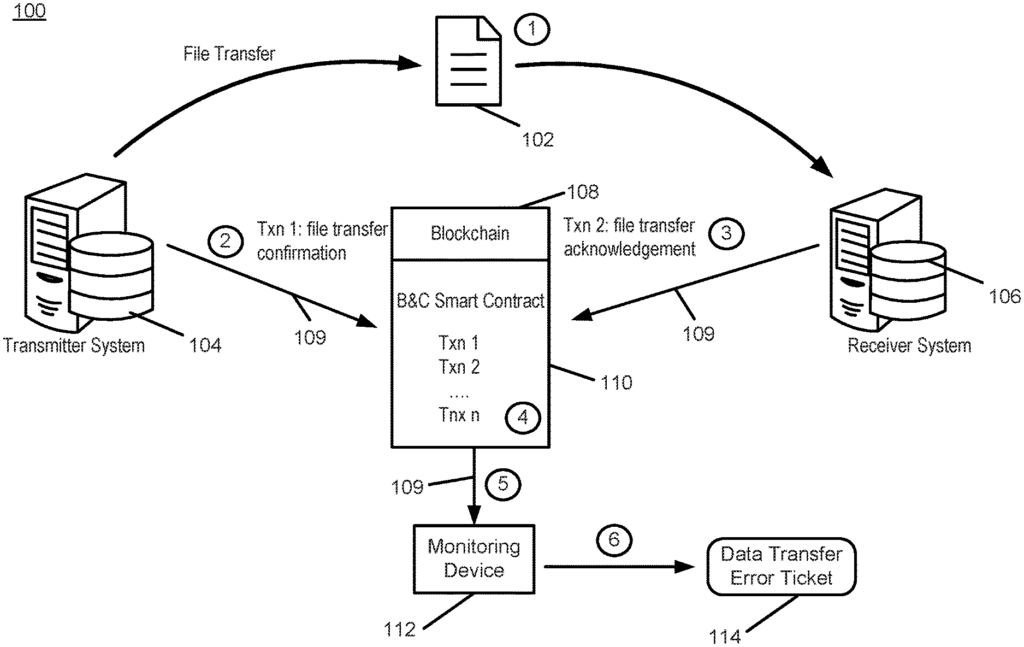
The American Express Travel Related Services Co Inc invention works as follows
A balance and control system can write a confirmation of a data-file transfer from a transmitter to a blockchain when the transmitter transmits a file to a recipient system. The confirmation includes a transmitter address, a receiver address, and the first hash for the data file. The system can also write an acknowledgement of a data transfer from a recipient system to the blockchain. This acknowledgement includes the transmitter system, the receiver system, and a 2nd hash of data file. The blockchain can execute a smartcontract to compare the hash of a data file with the hash for identifying an out-of balance file transfer event. The B&C system’s monitoring device may be able to read the out of balance file transfer event on the blockchain.
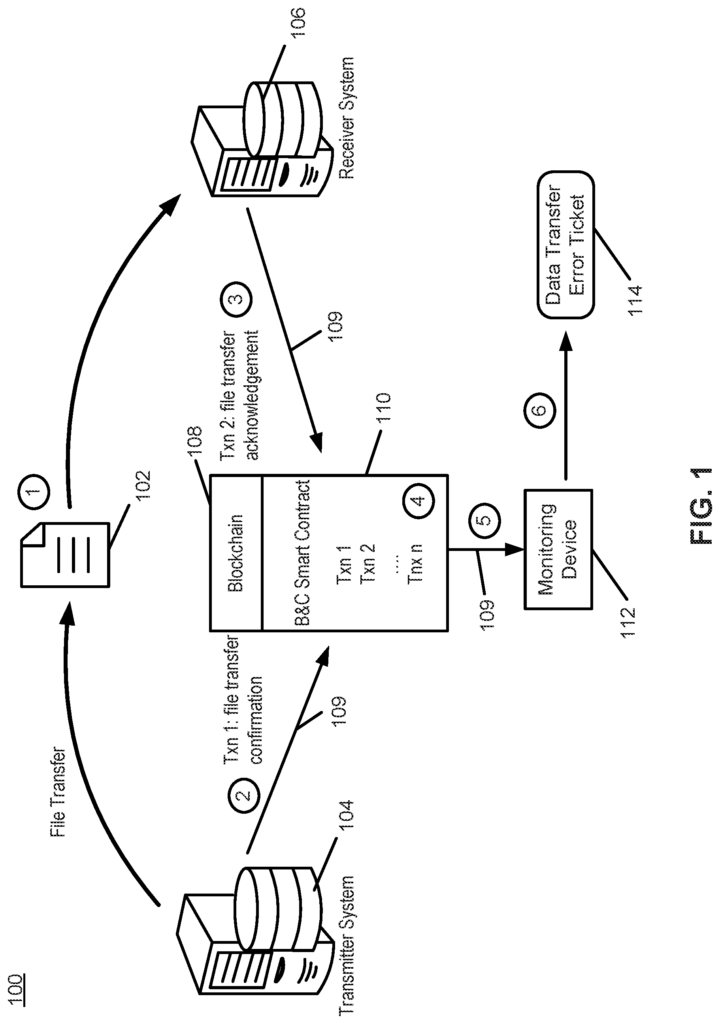
Background for Systems and Methods for Data File Transfer Balancing and Control on Blockchain
Data file transfer policies include audits of previous data file transfers in order to ensure that the data file transfers are accurate. Auditors may, for example, check previous data file transfers in order to confirm that credit applications submitted to financial institutions previously were accurate. Balancing and Control is the process that ensures data transfers between systems are accurate, complete and timely. B&C processes can be used to ensure that data files are transferred between systems in a timely, accurate, and complete manner. In a data file transfer with B&C processes in place, a sending and receiving system are both communicating with a third-party intermediary. The sending system transmits a data file to the receiver system. Both the sending and receiving systems send a trigger file with B&C information, and then the third party uses this information to validate the data file transfer.
Including a third-party in every data file transfer is problematic. Third-party systems and software are usually proprietary, and this increases the time required to develop and market new projects that use these systems. Third-party systems also complicate application design, since engineers must implement solutions that are compatible with third-party systems. Third-party systems introduce another point of failure to the balance and control systems. “The third party can be the central authority for the balancing process, but it may not be foolproof when it comes to the data that is received.
A system, method and computer-readable medium (collectively the?system?) A balancing system and control system that uses a distributed database, such as a blockchain, is disclosed. A data file transfer acknowledgement may be written from a system transmitter to a system receiver in response to the system transmitter transmitting a file to a system receiver. The confirmation includes a transmitter address, a recipient address and a first hash for the file. The system can also write an acknowledgement of a data transfer from a recipient system to the blockchain. This acknowledgement includes the transmitter system, the receiver system, and a 2nd hash of data file. The blockchain can execute a smartcontract to compare the first and second hashes of the file in order to identify an unbalanced file transfer. The out-of balance file transfer event can be read by a monitoring device in the system.
In various embodiments, a transmitter system address can include or be linked to a public and private key pair of asymmetric cryptography. The system can register the transmitter with the blockchain, by assigning the public key and private key of the key pair. The transmitter system can make an API request to write the confirmation of the data file transfer to the blockchain. The receiver system can also use an API to acknowledge the transfer of data files to the blockchain. The data file confirmation can include a timestamp as well as a filename and application ID. In response to identifying an error in the data file transmission, the system can generate a ticket.
The foregoing features and components may be combined without restriction in different combinations, unless otherwise indicated. The following description will make these features and elements, as well as their operation in the disclosed embodiments, more obvious.
BRIEF DESCRIPTION
The subject matter of this disclosure is specifically pointed out and clearly claimed in the final portion of the specification. The detailed description of the disclosure and the claims can be better understood when viewed in conjunction with the drawings, where like numbers denote similar elements.
FIG. “FIG.
FIG. “FIG.
FIG. “FIG.
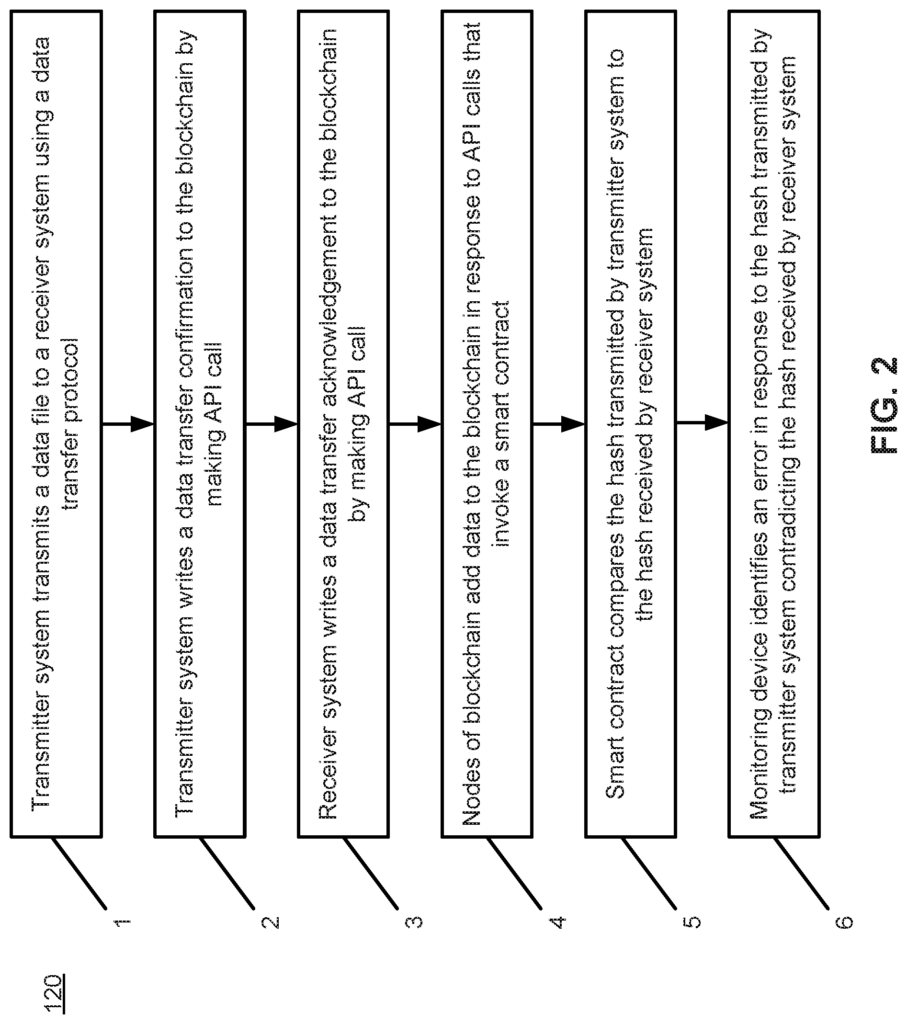
The detailed description refers to the accompanying illustrations, which show different embodiments as an illustration. These embodiments have been described in enough detail for those who are skilled to use the disclosure. However, other embodiments can be realized as well as logical and physical modifications without departing the spirit and scope. The detailed description is provided for illustration purposes only, and does not limit the disclosure. The steps described in the descriptions of methods or processes can be performed in any order. They are not restricted to the order shown. Any of the functions or processes can be performed or outsourced by a third party. “Any reference to the singular also includes plural embodiments and any reference referring to more than one element may include a single embodiment.
A balance-and-control system based upon peer-to-peer file transfers can be used to facilitate balance and controls of data file transfers, without (or minimal) third-party intervention. A blockchain-driven peer-to-peer file transfer network, for example, allows near-instant validation and logging of data file transfers. A governing group or consortium can control the access to data on a blockchain-based, peer-to-peer data file transfer system. The managing organization(s), may allow participation in the file transfer network.
The balance-and-control systems described herein utilize a distributed database that may be based upon a blockchain, and therefore have consensus-based transaction validation. Smart contracts may be used to enforce decentralized data file transfer workflows and track completed data file transfers. Balance and control systems can also be deployed on devices, such as computers, tablets or smartphones, Internet of Things (IoT) devices, etc. The applications can communicate with the blockchain in order to store information about file transfers, such as file names, hashes, source addresses, destination addresses, time stamps, application names, application IDs, or other data related to file transfers.
Referring to FIGS. According to different embodiments, FIGS. 1 and 2 show a Balance and Control (B&C), system 100 as well as a Balance and Control (B&C), process 120. B&C system may include a variety of computing devices and data structure in communication. B&C system may include a transfer of a data file (102), using a protocol to transfer data files, such as SSH file-transfer protocol, FTPS or another suitable protocol.
Blockchain 108″ may be a distributed data base that keeps records in a readable way and is resistant to tampering. The blockchain can be a network of blocks that contain data. The blocks may contain file transfer data or smart contract data. Each block can be linked to the previous one and include a timestamp. The blockchain can be used to record data file transfers, and other communications when implemented as part of B&C System 100. The blockchain can be a peer to peer network (e.g. Ethereum, Bitcoin etc.) that is either private, consortium or public. Public networks can leverage the computing power of a network to enhance security. “In that regard, the blockchain 108 can be implemented by using technologies like Ethereum GETH or eth-lightwallet.
Blockchain 108″ may be maintained by various nodes as copies of the Blockchain. The blockchain can be used to validate data file transfers by using consensus algorithms such as proof of work or proof of stake.
The various electronic communications in B&C system, including the transfer and confirmation of data files 102, the writing of data file transfer acknowledgments to blockchains 108 and/or reading of data from blockchains 108 can be achieved using a network. The term “network” is used in this document. Cloud computing, electronic communication systems or methods that include hardware or software components are included in the term “network”. Communication between the parties can be done through any communication channel, including a telephone network (point of sales device, personal digital assistance, cellular phone or tablet), an intranet, extranet, Internet and point of interaction devices. Online communications, satellite communication, off-line communication, wireless communications and transponder communications. Local area network, wide area network, virtual private network, networked devices, keyboards, mice, or any other suitable input or output device. The system can be implemented in a variety of ways, including TCP/IP, Appletalk IP-6, NetBIOS OSI, IPX, Appletalk IP-6, NetBIOS OSI or any other tunneling protocol. IPsec, SSH or any other protocol (existing or future) can be used. It may be beneficial to assume that the network has the characteristics of a public one, like the Internet. The specific information about the Internet’s protocols, standards and application software is well known by those in the know and as such does not need to be described here. “For example, see DILIP NAIK, INTERNET PROTOCOLS AND STANDARDS (1998), JAVA 2, various authors (Sybex, 1999), DEBORAH RAY AND ERIC RAY, MASTERING HTML 4.0 (1997); and LOSHIN TCP/IP EXPLAINED, (1997), and DAVID TOTTY and BRIAN TOTTY HTTP, THE DEFINITIVE GUIDE (2002). The contents of these publications are
A network can be insecure.” Data encryption may be used to secure communication over a network. Encryption can be done using any of the technologies that are currently available or will become available, e.g. Twofish, RSA El Gamal Schorr Signature, DSA PGP PKI GPG (GnuPG), symmetric and asymmetric systems. “Asymmetric encryption can be used to sign and verify signatures in blockchain crypto operations.
In different embodiments, the transmitter system 104 can write a confirmation of a file transfer to the blockchain. (Step 2) The confirmation can include metadata about the file transfer that is known to transmitter system 104. Metadata for a particular file transfer can include, for example, data such as a file name or hash, source address, destination address, time stamp, application name and/or application ID.
In various embodiments the source address and destination addresses may be blockchain address. Each system or application can have its own unique blockchain address. This allows the address to be used as a means of identifying systems and/or apps on a one-to-1 basis. The address can be the public-key of a public/private cryptography key pair that is assigned to a particular system or application. In the fields for the source or destination address, an alias associated with the public-key may be used.
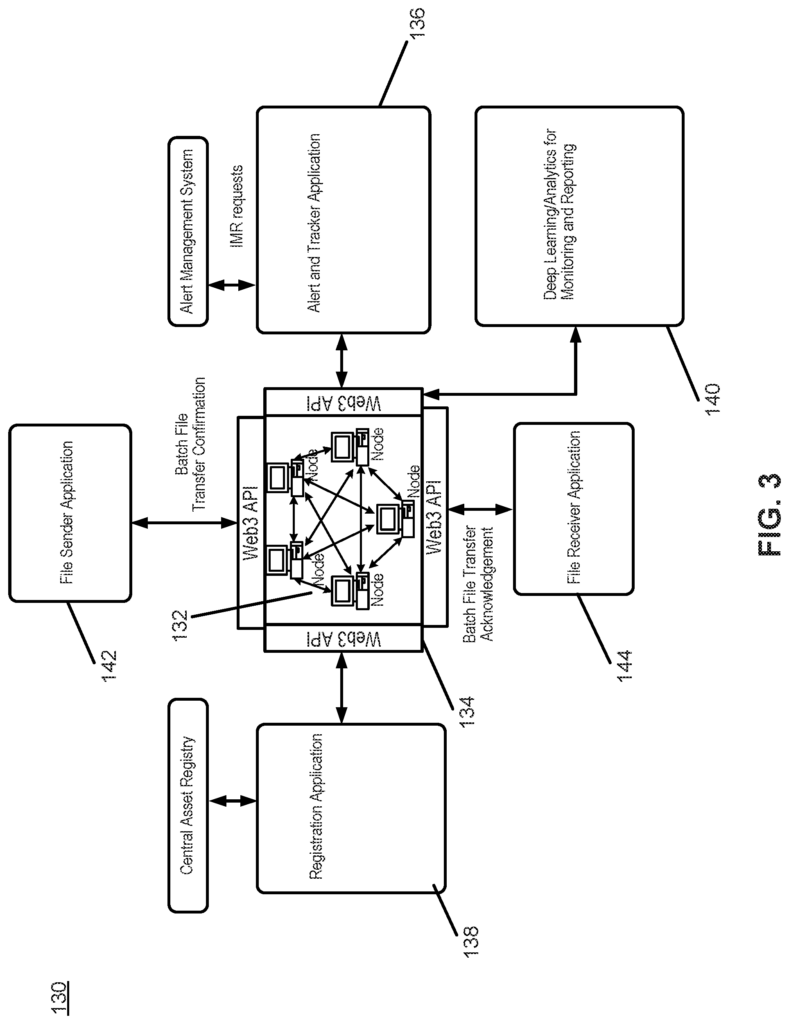
Click here to view the patent on Google Patents.
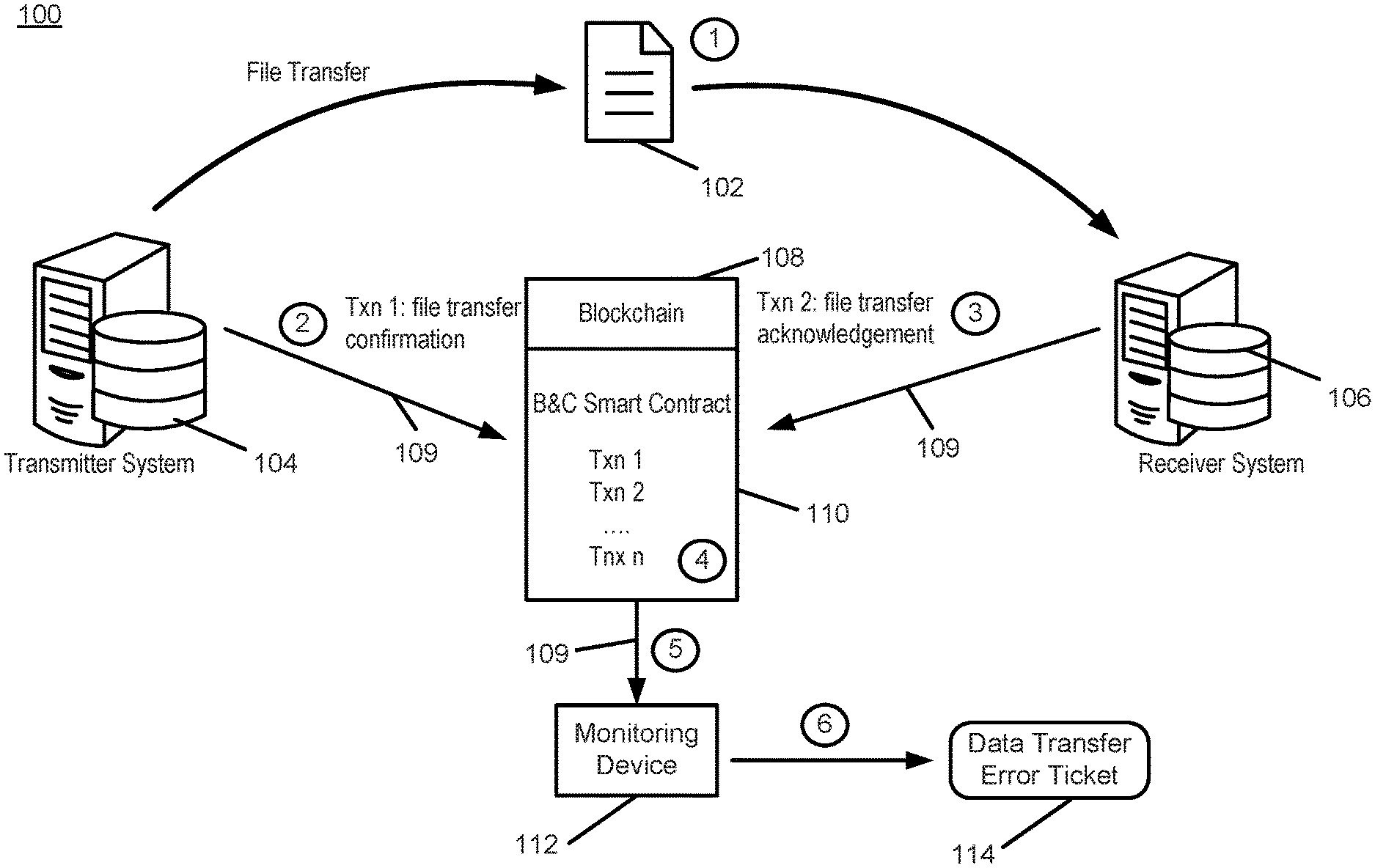
Leave a Reply